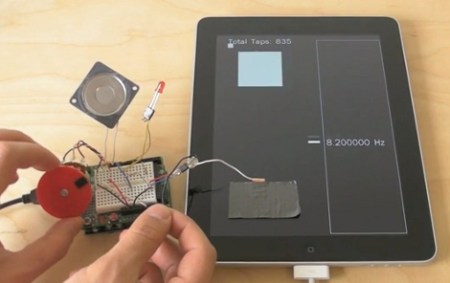
Fanboys may be in shock from seeing duct tape applied to the screen of an iPad, but we can assure you it’s in the name of science. [Michael Knuepfel] is working on his thesis for the ITP graduate program at the Tisch School for the Arts. He managed to augment the usability of touchscreen devices by adding hardware to them.
What he’s come up with are devices for both input and output. The output devices generally rely on light and color of light displayed on the screen itself which is picked up by a light sensor. The input devices use conductive material to complete a path between your hand and your screen. This lets the capacitive sensing screen detect the presence of your hand, through the conductor. Some of his example devices include gaming controller overlays, encoder rings, and multiple stylus designs.
After the break we’ve embedded [Michael’s] teaser trailer which jumps through several demonstrations. It’s plenty to get your mind rolling, but if you want to know more you must watch his thesis presentation. It’s available as an MP4 download on this page. Just search for his name, [Michael Knuepfel] for the proper link.
[vimeo http://vimeo.com/23507405 w=470]
[via Make]















The game controller was especially interesting . This is going to be huge.
What is this “after the break” nonsense?
Really awesome, Mike!
James – it’s after the break…
Not sure where it started from but for me I see all the text in my RSS feed but youtube videos don’t show up through it so it lets me know there is one.
Pretty neat implementations – there’s the joystick device you can buy at the moment but the game controller buttons are pretty neat – could simply be integrated into a case for the iPhone…
I was about to do this with my 120 euro Nokia 5800. It has GPS and big display. My intentions were to control servos with light sensors taped to display. Purpose would be to control unmanned small boat. It would also send location information through 3G. Software is easy to create with Python.
I’d like to see the time machine that was used to show that glimpse into the future. ;)
@James
The “break” is a newspaper turned web development term meaning the part of the page that you have to scroll(or clicked on HaD) down to see.
lol that was supposed to be “” bur it just wrote it as a linebreak :/
fail
so i’m wondering. can you make an app for the ipad that can read and interpret the signals sent through the touch pad as a data connection? what i mean is, can you create a device that will wirelessly transfer a file over to the ipad though the resistance values of the touch pad with the aid of an application to help translate it? that would be awesome to use if you want to send someone a file via an audio port or something on say an airplane where wireless connectivity is forbidden. I suppose you could also use it to gain access to the system files of the ipad by giving it unsigned code.
If you stick and unstick a piece of tape to your clothes a couple of times it will still work and release much easier and cleaner when it is time to.
not bad
@strider_mt2k
don’t use duct tape. cheapo scotch tape should do the job swell. but i suppose for a full contact you would need something with the holding power of duct tape.
go to wallmart and see a kiosk. It has a black rod sticking out the top, attached with some disk with rubber trimming. Has something called “Ad Touch Technology” printed on the box’s sign. Some more lines with instructions that read:
Download AdTouch to your android or iphone and touch here for new specials and coupons.
The old Psion Organiser 3 pocket computer had a circuit like this built once, I think in a magazine. The inventor wanted serial output from the Psion, which it didn’t have. So flashing a square on and off (4-shade LCD screen) was detected thru a capacitive link.
This was of course capacitive *output*, detecting the pulses sent thru the LCD. I imagine it was limited by the screen’s electronic refresh rate, but not the LCD crystal’s response time. A sensitive circuit detected the voltage sent to the screen to turn that square black / white.
Could have done it optically, I suppose, but I think the advantage is, you wouldn’t have to wait for the slow, early 1990s LCD crystals to catch up to their driving voltage.
The circuit I mention is essentially the opposite of the capacitive input the chaps have invented here. Interesting how things pop up again in different ways, as technology advances.